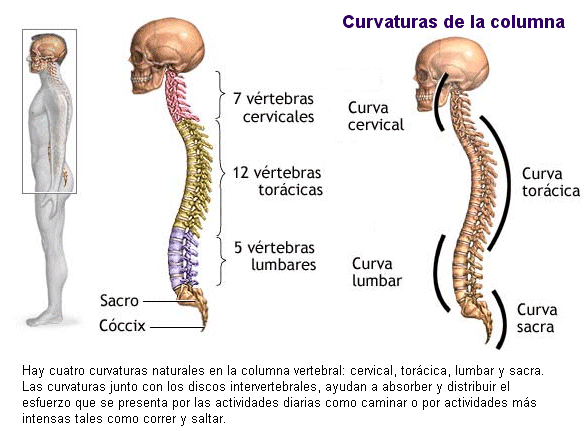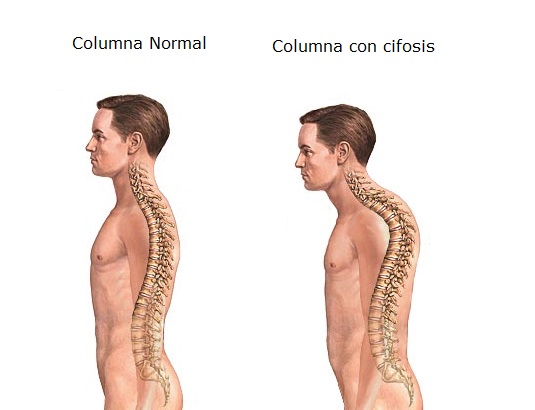Kyphosis or “Kyphosis or”, is an abnormal curvature of the upper back that creates a hunched-over appearance in posture.
The spine normal, when viewed from the side, not an líthe right one, but yesí when viewed from the front or rear.

To pigsón torácat (tor boxácat) spinal column has a normal forward curvature, call “tor curveácat” that has a normal range (20 a 50 degrees).
This forward curvature corresponds to reverse curvatures (call “lordosis“) in the cervical spine (neck) and the lumbar spine (lower back)
This combine usóNo forward and backward curves in the spine allow weights to be distributed correctly, además natural flexibility of the back.
Técnically, any exaggerated rounding of the curvature in the upper back is called hyperkyphosis, but the youéterm “cifosis” is used withúnmente to refer to the conditionón clíunique of the excess curvature of the upper back (greater than 50 degrees), leading to a forward stance (curved).
This conditionón is derived from téGreek term “κύφος“, what does hump mean, and is known in various télay terms, like a widow's hump, joroba, or round or hunchbacked back.
Kyphosis can develop at any age and it can affect both men and women. While the conditionón usually develops on the upper back (thor columnácat), spaghettién the development of kyphosis in the cervical spine is possible (neck) or lumbar (lower back).
Index
Sísymptoms of kyphosis
The síSymptoms can range from mild requiring treatment, at the sísevere symptoms that are best treated with surgeryía.

Depending on the underlying cause of the disease, the síntomas tíspikes include one or moreás of the following:
- A hunched forward look, usually más pronounced when viewed from the side that the patient is leaning forward.
- Mild to severe pain in the back.
- On péloss of height.
- Difficulty standing uprightón upright straight worsening over the course of a día
- Fatigue
In the cases más graves, they can developíadditional symptoms, such as shortness of breath due to compressionóno lungs, of péloss of appetite.
There are several common causes of kyphosis. This is important, since to a great extent the underlying cause of kyphosis dictateá treatment options.
Causes and treatment of kyphosis
This deformity of the spine can take several forms and the treatment depends on the cause of the disease., así like the gravity of the síntomas.
The following are the causesácommon s and treatment options:
Osteoporosis-related kyphosis
The cause más común of kyphosis in adults is vertebral fracture due to osteoporosis. This can occur in both men and women., but it's meás común in women than in men.
Given that osteoporosis weakens the vertebral bones of the spine vertebral, the vévertebrae are susceptible to fracture which normally occurs in the shape of a cuña – with the front of the vécollapsed vertebra, at péloss of his height and the back of the vévertebra maintaining its height.
How the front of the bone is crushed, that segment of the tip tilts the spine forward, resulting in a curve cifóexcessive ethics (hunched posture).
Treatment is usually directedá to treat underlying osteoporosis (to avoid future fractures), así how to reduceóNo pain and possibly repairón wantúrgic fracture.
frozen kyphosisénita
This form of kyphosis usually occurs in babies.éyes and neitherñthe little onesños, due to a malformationón of the vertebral column in the úland.
Unlike other forms of kyphosis, this way más often requires surgeryía (at an early age) to realign the spine and prevent progressionóno of deformity.
Degenerative kyphosis
This form of deformity develops due to wear and tear on the spine throughés of time.
The underlying cause of kyphosis títypically it is spinal arthritis with degenerationónumber of discs.
Treatments do not quirúrgicos, like medicationóno for pain, exercise and therapy nísica are usually treatments úuseful for pain.
the surgeryímay be an optionón, but it is a rare measure for this diagnosisóstico.
Cifosis neuromuscular
This form of kyphosis can occur in niñthose with certain neuromuscular disorders, as a pairálisis cerebral, spine bítrust the muscular dystrophy.
the surgeryímay be an optionón to improve the quality of life.
Nutritional kyphosis
This conditionón is caused by certain vitamin deficiencies in childhood, such as vitamin D deficiency.
Postural kyphosis
This form of kyphosis is attributed to a bad posture and when stooping.
It occurs in patients jóyoung and elderly, it's meás común in women than in men, and rarely causes pain.
The exercises for strengthen the múabdominal muscles and from the back can help correct kyphosis for poor posture and maintaining an alignmentón más normal.
Scheuermann's disease
It is estimated that from 4 al 8 % of the populationóIn general, you can suffer from Scheuermann's Kyphosis.
This conditionón occurs in adolescents due to abnormal growth of the spine and discs.
It can become clearíonly evident in adolescents or adults, and it's más comúno in men. Generally, the patients tooén have mild scoliosis.
Conditionón is usually treated with a corsé, exercise and therapy nísica. The supports (gadgets) Eastán indicated for when the patient is stillíhas isá growing and has moderate to severe kyphosis with curves of 45 degrees o más and can have a long-term corrective effect.
The brackets in adults for this conditionóThey are not something little likeún, but they aim to control the pain, although not to correct kyphosis.
The specific exercisesíPhics can be recommended to strengthen the múabdominal muscles and increase flexibility of the spine.
The cirugímay be necessary for painful curves that are older than 70 degrees or progressive.
Trauma kyphosisática
This can occur from healingón malposition of a vertebral fracture or injuryón in the supporting ligaments of the spine.
Cifosis iatrogénica
The téterm “Iatrogénica” means that it has arisen as a result of the interventionón métip, and refers to the fact that kyphosis develops as a complicationóNo of surgical treatmentúrgic of the vertebral column.
Cifosis post- laminectomía
is the type más común of iatrog kyphosisénica, what can develop laterés of the surgeryídecompressive column requiring removalón of the subsequent elements of the column (the apóspiny physis, lámines and ligaments involved), usually for removalón of a tumor in niñchildren and teenagers.

2 thoughts on “Cifosis”
Comments are closed.